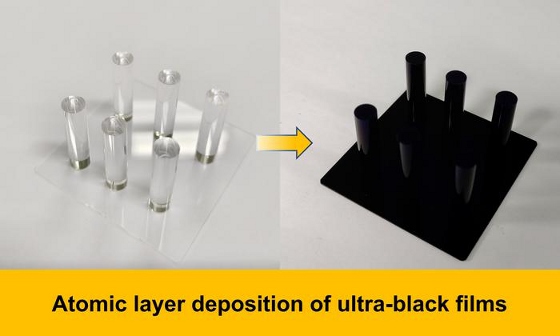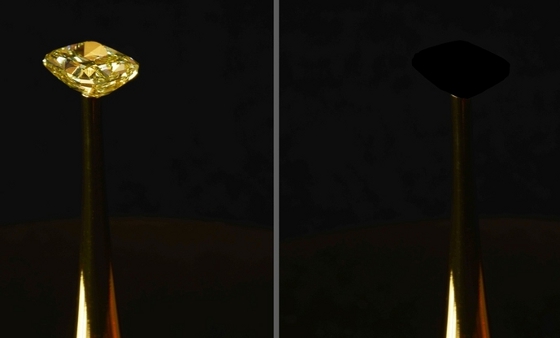 |
| March 26, 2024 | Volume 20 Issue 12 |
Designfax weekly eMagazine
Archives
Partners
Manufacturing Center
Product Spotlight
Modern Applications News
Metalworking Ideas For
Today's Job Shops
Tooling and Production
Strategies for large
metalworking plants
Ultrablack coating could make next-gen telescopes even better

A new ultrablack coating created by researchers at the University of Shanghai can be applied to curved surfaces and magnesium alloys to trap nearly all light. [Credit: Jin et al.]
Sometimes, seeing clearly requires complete darkness. For astronomy and precision optics, coating devices in black paint can cut down on stray light, enhancing images and boosting performance. For the most advanced telescopes and optical systems, every little bit matters, so their manufacturers seek out the blackest blacks to coat them.
As reported recently in the Journal of Vacuum Science & Technology A by AIP Publishing, researchers from the University of Shanghai for Science and Technology and the Chinese Academy of Sciences developed an ultrablack thin-film coating for aerospace-grade magnesium alloys. Their coating absorbs 99.3% of light while being durable enough to survive in harsh conditions.
For telescopes operating in the vacuum of space, or optical equipment in extreme environments, existing coatings are often insufficient.
"Existing black coatings like vertically aligned carbon nanotubes or black silicon are limited by fragility," said author Yunzhen Cao. "It is also difficult for many other coating methods to apply coatings inside a tube or on other complicated structures. This is important for their application in optical devices, as they often have significant curvature or intricate shapes."
To solve these problems, the researchers turned to atomic layer deposition (ALD). With this vacuum-based manufacturing technique, the target is placed in a vacuum chamber and sequentially exposed to specific types of gas, which adhere to the object's surface in thin layers.
"One big advantage of the ALD method lies in its excellent step-coverage ability, which means we can obtain uniform film coverage on very complex surfaces, such as cylinders, pillars, and trenches," said Cao.
To make their ultrablack coating, the team used alternating layers of aluminum-doped titanium carbide (TiAlC) and silicon nitride (SiO2). The two materials work together to prevent nearly all light from reflecting off the coated surface.
"TiAlC acted as an absorbing layer, and SiO2 was employed to create an anti-reflection structure," said Cao. "As a result, nearly all of the incident light is trapped in the multilayer film, achieving efficient light absorption."
In tests, the team found an average absorption of 99.3% across a wide range of light wavelengths, from violet light at 400 nm all the way to near infrared at 1,000 nm. Using a special barrier layer, they even applied their coating to magnesium alloys, which are often used in aerospace applications but are easily corroded.
"What's more, the film shows superb stability in adverse environments and is tough enough to withstand friction, heat, damp conditions, and extreme temperature changes," said Cao.
The authors hope their coating will be used to enhance space telescopes and optical hardware operating in the most extreme conditions and are working to further improve its performance.
"Now that the film can absorb over 99.3% of incoming visible light, we're hoping to expand its light absorption range even further to include ultraviolet and infrared regions," said Cao.
Is this the blackest coating available?
The short answer is no. For commercially available ultrablack coating solutions, that title goes to a product developed by UK-based Surrey NanoSystems called Vantablack, which absorbs up to 99.9% of visible light. Not just anybody can use this formulation, though (parts must be sent to the company to be coated), which is one of many reasons why other formulations like the one discussed above are needed.

In 2019, an art piece made by MIT artist-in-residence Diemut Strebe in collaboration with Brian Wardle, professor of aeronautics and astronautics at MIT, featured a $2-million 16.78-carat natural yellow diamond the team coated with MIT's latest ultrablack CNT material. Normally brilliantly faceted, the gem appeared as a flat, black void. [Credit: Image by Diemut Strebe]
MIT researchers reported in 2019 that they had "cooked up a material that is 10 times blacker than anything that has previously been reported" -- including Vantablack. The material was made from vertically aligned carbon nanotubes (CNTs) grown on foil, which "captures at least 99.995% of any incoming light." According to the researchers, if an object coated with this material "contained any bumps or ridges, or features of any kind, no matter what angle it was viewed from, these features would be invisible, obscured in a void of black." They also say the material is tough (compared to earlier versions made of CNTs) and should hold up to the challengers of space. To date, however, this material is not available commercially.
Sources: American Institute of Physics, Surrey NanoSystems, MIT
Published March 2024
Rate this article
View our terms of use and privacy policy
